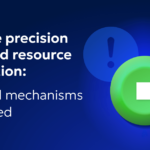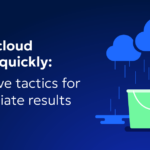
Is the On-Demand Era Over?

Senior Content Manager
We live in the epitome of the on-demand era. Instant gratification means everything and the flexibility of going with the flow is treasured. In this environment, it’s no wonder engineers favor pay-as-you-go On-Demand Instances.They are after all, the embodiment of the cloud dream: you pay for what you want when you want it so it’s easy to scale up and down in seconds.
But when it comes to the cloud, convenience has a cost. And the cost of On-Demand has a tremendous impact on a company’s cloud bill and ultimately, its ROI.
So what’s the alternative if you’re looking for both flexibility and cost efficiency? Read on to understand why you’re stuck using On-Demand and how to leverage cost-efficient pricing models without making compromises.
So why do you use On-Demand Instances?

On-Demand Instances are the most expensive of the pricing models offered by AWS, but they are by no means the only one you can leverage. AWS offers Reserved Instances at up to a 72% discount, Savings Plans at up to a 64% discount, and Spot Instances for a whopping 90% discount.
So why are so many engineers stuck paying On-Demand?
By their nature, our cloud environments are incredibly dynamic. They shift depending on our workload requirements which can vary with each new customer, feature, or a change in architecture. It’s almost impossible to know in what ways they will change.
As a result, accurately predicting our cloud usage is hard. And both RIs and SPs require you to commit far in advance, making forecasting usage extra challenging. After all, if you’re a SaaS company, how do you know how many new customers you’ll onboard next year or what the product requirements there will be in three years from today? You may also begin using popular tools like Kubernetes which will inevitably require changes in your architecture.
Despite all these factors, cost-efficient pricing models like Reserved Instances and Savings Plans do not account for this unpredictability. Depending on the family type you select, RIs require you to commit to a particular number of specific instance types 1-3 years in advance, while SPs require you to commit to spending a certain amount of compute per hour for a specific instance family 1-3 years in advance. Even for the most commitment-friendly out there, that’s way too many variables to manage to feel confident in such a long-term investment.
For this reason, RIs and SPs become a huge operational burden. Engineers will try and forecast their future usage which takes a tremendous amount of planning and calculation both mathematically and with regards to future product requirements. Yet even with all this work, accuracy is not guaranteed which results in low savings coverage, and a dependence on On-Demand Instances.
Spot Instances offer another alternative. However, their 90% discount comes at a steep price. If someone else is willing to use the same instance at the On-Demand price, your Spot Instance will be transferred to that individual with only a two-minute warning. As a result, Spot Instances are only good for workloads that are not mission-critical. Additionally, running a specific service as a Spot Instance requires engineers to develop it to be fault-tolerant. This means engineering effort will be focused on optimizing the service for costs, rather than further innovating and developing the product.
What’s the alternative?

Engineers use On-Demand because it enables them to scale without making predictions, without making adjustments, and without any commitment. This is critical to them because accurately scaling in a manner that emphasizes cost efficiency is humanly impossible. We cannot possibly make accurate assessments of our future usage and optimize our cloud architecture accordingly on our own.
Yet, On-Demand Instances are expensive and using them for a large portion of your compute will have a negative impact on your business’s cloud bill.
It may look like you’re simply supporting your business’s scale, but overtime, you are cannibalizing your company’s revenue stream.
So how can we rise above this challenge? First, we have to find a way to leverage RIs without the need to predict our usage in the long term.
And that’s a mission made for machines. Smart AI algorithms can measure your current usage and understand your needs at any given moment. If you scale up, it will know you need to purchase more commitments. Likewise, if you scale down, it will know you need to sell them. With this information, it can automatically adjust your commitments to fit with your environment as you scale.
This will enable you to leverage RIs without the burden of calculating your usage 1-3 years in advance–a dream come true for those seeking flexibility, cost efficiency, and accuracy.
Best of all, AI will manage your commitments for you with no manual effort and zero interference from your engineering team. This offloads a tremendous burden on their end and frees them up to work on more projects that impact revenue.
Welcome to the future

So does the addition of AI mean the On-Demand era is over? Not entirely.
On-Demand Instances can still be used for short-term usage peaks that don’t require commitments.
At the same time however, AI will diminish the need for On-Demand as it enables engineers to maximize their RI coverage without sacrificing flexibility.
And that’s exactly what you get with Zesty’s Commitment Manager. The Commitment Manager’s AI engine works in real-time to leverage the most lucrative deals on the RI Marketplace and grabs them for our customers the second they’re published. We do this by analyzing your current usage as well as the RI marketplace behavior to purchase the right commitments as you need them and sell them when you don’t. This way, you are never paying for resources you’re not using. But once you need more Instances, you’re scaling in seconds without any human intervention. As a result, you cut EC2 costs by over 50%, eliminate the temptation to overprovision resources, and ensure you always reach optimal commitment utilization.
Best of all, your engineers will no longer be obliged to manage the cloud, freeing them to build more products and features that increase your bottom line.
Are you ready to see how you can maximize cloud savings without compromising on flexibility?
Chat with one of our cloud experts to hear about our EC2 Commitment Manager and our new EBS auto-scaler, Zesty Disk.
Related Articles
-
 Zesty introduces Insights: actionable recommendations for immediate cloud savings
Zesty introduces Insights: actionable recommendations for immediate cloud savings
July 24, 2024 -
 Zesty introduces Commitment Manager for Amazon RDS!
Zesty introduces Commitment Manager for Amazon RDS!
July 10, 2024 -
 How to clear budget for AI implementation?
How to clear budget for AI implementation?
June 18, 2024 -
 Ensure precision in cloud resource allocation: Control mechanisms you need
Ensure precision in cloud resource allocation: Control mechanisms you need
June 16, 2024 -
Slash Cloud Waste Quickly: Effective Tactics for Immediate Results
June 4, 2024




